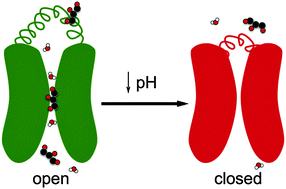Exploring the gating mechanisms of aquaporin-3: new clues for the design of inhibitors?†
Abstract
The pH gating of human AQP3 and its effects on both water and glycerol permeabilities have been fully characterized for the first time using a human red blood cell model (hRBC). For comparison, the effects of pH on the gating of rat AQP3 have also been characterized in yeast. The obtained results highlight similarities as well as differences between the two isoforms. In addition, we investigated the molecular mechanism of hAQP3 pH gating in silico, which may disclose new pathways to AQP regulation by small molecule inhibitors, and therefore may be important for drug development.

- This article is part of the themed collection: Chemical Biology in Molecular BioSystems

 Please wait while we load your content...
Please wait while we load your content...